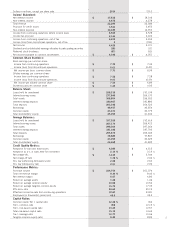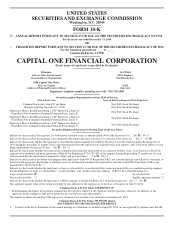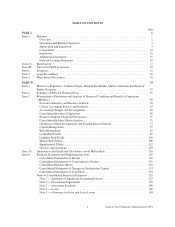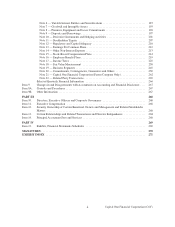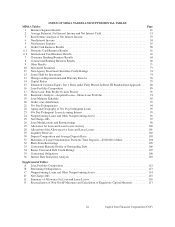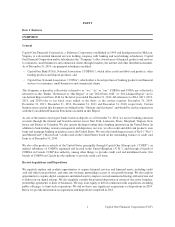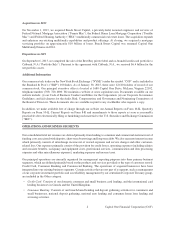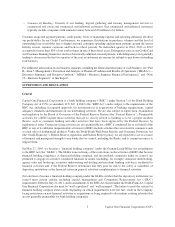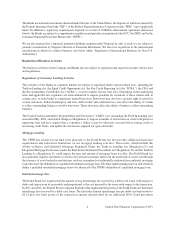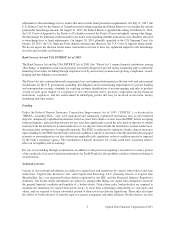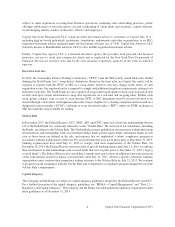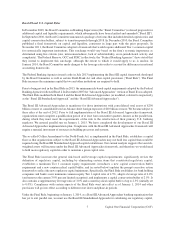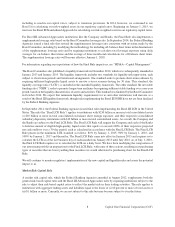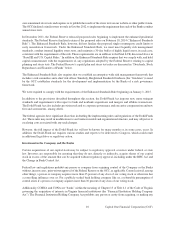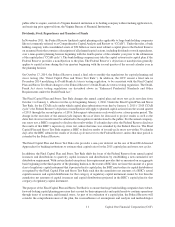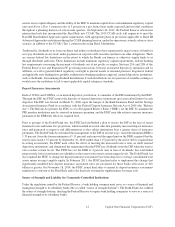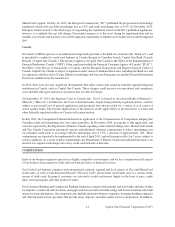Capital One 2014 Annual Report Download - page 26
Download and view the complete annual report
Please find page 26 of the 2014 Capital One annual report below. You can navigate through the pages in the report by either clicking on the pages listed below, or by using the keyword search tool below to find specific information within the annual report.The Banks are national associations chartered under the laws of the United States, the deposits of which are insured by
the Deposit Insurance Fund (the “DIF”) of the Federal Deposit Insurance Corporation (the “FDIC”) up to applicable
limits. In addition to regulatory requirements imposed as a result of COBNA’s international operations (discussed
below), the Banks are subject to comprehensive regulation and periodic examination by the OCC, the FDIC and by the
Consumer Financial Protection Bureau (the “CFPB”).
We are also registered as a financial institution holding company under Virginia law and, as such, we are subject to
periodic examination by Virginia’s Bureau of Financial Institutions. We also face regulation in the international
jurisdictions in which we conduct business (see below under “Regulation of International Business by Non-U.S.
Authorities”).
Regulation of Business Activities
The business activities of the Company and Banks also are subject to regulation and supervision under various laws
and regulations.
Regulations of Consumer Lending Activities
The activities of the Banks as consumer lenders are subject to regulation under various federal laws, including the
Truth in Lending Act, the Equal Credit Opportunity Act, the Fair Credit Reporting Act (the “FCRA”), the CRA and
the Servicemembers Civil Relief Act (“SCRA”), as well as under various state laws. Depending on the underlying
issue and applicable law, regulators are often authorized to impose penalties for violations of these statutes and, in
certain cases, to order banks to compensate injured borrowers. Borrowers may also have a private right of action for
certain violations. Federal bankruptcy and state debtor relief and collection laws also affect the ability of a bank
to collect outstanding balances owed by borrowers. These laws may affect the ability of banks to collect outstanding
balances.
The Credit Card Accountability Responsibility and Disclosure (“CARD”) Act (amending the Truth In Lending Act)
enacted in May 2009, and related changes to Regulation Z, impose a number of restrictions on credit card practices
impacting rates and fees, require that a consumer’s ability to pay be taken into account before issuing credit or
increasing credit limits, and update the disclosures required for open-end credit.
Mortgage Lending
The CFPB has issued several final rules pursuant to the Dodd-Frank Act that provide additional disclosure
requirements and substantive limitations on our mortgage lending activities. These rules, which include the
Ability-to-Repay and Qualified Mortgage Standards Under the Truth in Lending Act (Regulation Z) and
Integrated Mortgage Disclosures under the Real Estate Settlement Procedures Act (Regulation X) and the Truth In
Lending Act (Regulation Z), could impact the type and amount of mortgage loans we offer. The Dodd-Frank Act
also generally requires securitizers to retain a five percent economic interest in the credit risk of assets sold through
the issuance of asset-backed securitizations, with an exemption for traditionally underwritten residential mortgage
loans that meet the definition of a qualified residential mortgage loan. The final implementing rules on risk retention
define a qualified residential mortgage loan to be identical to the CFPB’s definition of a qualified mortgage loan.
Debit Interchange Fees
The Dodd-Frank Act requires that the amount of any interchange fee received by a debit card issuer with respect to
debit card transactions be reasonable and proportional to the cost incurred by the issuer with respect to the transaction.
In 2011 and 2012, the Federal Reserve adopted final rules that implement the portion of the Dodd-Frank Act that limits
interchange fees received by a debit card issuer. The final rules limited interchange fees per debit card transaction to
$0.21 plus five basis points of the transaction amount and provided for an additional $0.01 fraud prevention
4Capital One Financial Corporation (COF)



